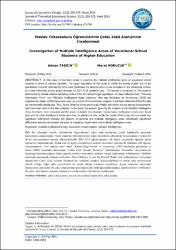| dc.contributor.author | Taşgın, Adnan | |
| dc.contributor.author | Korucuk, Murat | |
| dc.date.accessioned | 2021-07-27T09:22:38Z | |
| dc.date.available | 2021-07-27T09:22:38Z | |
| dc.date.issued | 30.04.2019 | en_US |
| dc.identifier.citation | Taşgın, A , Korucuk, M . (2019). Meslek Yüksekokulu Öğrencilerinin Çoklu Zekâ Alanlarının İncelenmesi . Journal of Theoretical Educational Science , 12 (2) , 550-575 . DOI: 10.30831/akukeg.426706 | en_US |
| dc.identifier.uri | https://dergipark.org.tr/tr/download/article-file/692048 | |
| dc.identifier.uri | https://hdl.handle.net/11630/8926 | |
| dc.description.abstract | Bu çalışmada üniversite öğrencilerinin çoklu zekâ alanlarının çeşitli değişkenler açısından incelenmesi amaçlanmıştır. Nicel araştırma yöntemlerinden tarama modelinin kullanıldığı bu çalışmanın evrenini bir devlet üniversitesinin meslek yüksekokulunda 2017 - 2018 eğitim - öğretim yılı bahar yarıyılında öğrenim gören öğrenciler oluşturmaktadır. Örneklemi ise ilgili evrenden basit seçkisiz örnekleme yöntemi ile belirlenen 260 öğrenci oluşturmaktadır. Veri toplama aracı olarak “Kişisel Bilgi Formu” ve Armstrong (1993) tarafından geliştirilen ve Saban (2002) tarafından düzenlenen “Çoklu Zekâ Alanları Envanteri” kullanılmıştır. Normallik varsayımlarının karşılanıp karşılanmadığına ilişkin yapılan analizler sonucunda verilerin normal dağılmadığı belirlenmiştir. Verilerin analizinde parametrik olmayan testlerden, Mann Whitney U testi ile Kruskal Wallis testi kullanılmıştır. Çalışmada öğrencilerin Çoklu Zekâ Alanları Envanteri’ne verdikleri cevaplar değerlendirilmiş ve sosyal zeka seviyelerinin yüksek olduğu, diğer zeka seviyelerinin ise düşük olduğu sonucuna ulaşılmıştır. Ayrıca araştırma sonucunda öğrencilerin cinsiyetleri ile çoklu zeka alanları arasında anlamlı farklılığa rastlanmazken, öğretim türleri ve bölümleri ile çoklu zeka alanları arasında istatistiksel olarak anlamlı farklılıklara rastlanmıştır. | en_US |
| dc.description.abstract | In this study, it has been aimed to examine the multiple intelligence areas of vocational school students in terms of various variables. The target population of this study in which the survey model, one of the quantitative research methods has been used constitutes the students who receive education in the vocational schools of a state university during spring semester of 2017-2018 academic year. The sample is composed of 260 students determined by simple random sampling method from the related target population. As data collection tool, "Personal Information Form" and "Multiple Intelligence Areas Inventory" that was developed by Armstrong (1993) and organized by Saban (2002) have been used. As a result of the normality analyses, it has been determined that the data are not normally distributed. Thus, Mann Whitney U test and Kruskal Wallis test which are not among the parametric tests have been used in the data analyses. In the study, the answers given by the students to the Multiple Intelligence Areas Inventory were evaluated and the results indicated that students’ interpersonal intelligence levels were found high and the other intelligence levels were low. In addition to this, while the results of the study did not reveal any significant differences between the genders of students and multiple intelligence areas, statistically significant differences were found between the types of education, departments and multiple intelligence areas. | en_US |
| dc.language.iso | tur | en_US |
| dc.publisher | Afyon Kocatepe Üniversitesi | en_US |
| dc.identifier.doi | 10.30831/akukeg.426706 | en_US |
| dc.rights | info:eu-repo/semantics/openAccess | en_US |
| dc.subject | Çoklu Zekâ Kuramı | en_US |
| dc.subject | Meslek Yüksekokulu Öğrencileri | en_US |
| dc.subject | Zekâ Alanları | en_US |
| dc.subject | Multiple Intelligence Theory | en_US |
| dc.subject | Vocational School Students | en_US |
| dc.subject | Multiple Intelligences | en_US |
| dc.title | Meslek yüksekokulu öğrencilerinin çoklu zekâ alanlarının incelenmesi | en_US |
| dc.title.alternative | Investigation of multiple ıntelligence areas of vocational school students of higher education | en_US |
| dc.type | article | en_US |
| dc.relation.journal | Kuramsal Eğitimbilim Dergisi | en_US |
| dc.department | Fakülteler, Eğitim Fakültesi, Eğitim Bilimleri Bölümü | en_US |
| dc.authorid | 0000-0002-3704-861X | en_US |
| dc.authorid | 0000-0001-5147-9865 | en_US |
| dc.identifier.volume | 12 | en_US |
| dc.identifier.startpage | 550 | en_US |
| dc.identifier.endpage | 575 | en_US |
| dc.identifier.issue | 2 | en_US |
| dc.relation.publicationcategory | Makale - Ulusal Hakemli Dergi - Başka Kurum Yazarı | en_US |



















